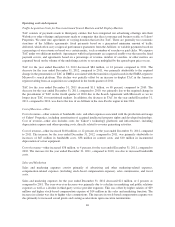Yahoo 2012 Annual Report Download - page 68
Download and view the complete annual report
Please find page 68 of the 2012 Yahoo annual report below. You can navigate through the pages in the report by either clicking on the pages listed below, or by using the keyword search tool below to find specific information within the annual report.Cash flow changes
Cash provided by operating activities is driven by our net income, adjusted for non-cash items, working capital
changes and dividends received from equity investees. Non-cash adjustments include depreciation, amortization
of intangible assets, stock-based compensation expense, non-cash restructuring charges, tax benefits from stock-
based awards, excess tax benefits from stock-based awards, deferred income taxes, and earnings in equity
interests. We had a net use of cash in the year ended December 31, 2012 primarily due to a cash tax payment of
$2.3 billion related to the sale of Alibaba Group Shares. Offsetting this use, we generated adjusted EBITDA of
$1.7 billion, received a payment from Alibaba Group of $550 million in satisfaction of certain future royalty
payments, and received dividends from Yahoo Japan of $84 million. Cash provided by operating activities was
higher than net income in the year ended December 31, 2011 mainly due to non-cash items included in net
income. Cash provided by operating activities was slightly lower than net income in the year ended
December 31, 2010 due to non-cash items included in net income and changes in working capital, including
lower collections on accounts receivable, higher tax payments, and Microsoft reimbursements not yet received as
cash.
Cash provided by investing activities is primarily attributable to capital expenditures, purchases, sales and
maturities of marketable debt securities, purchases of intangible assets, sales of other assets, as well as
acquisitions including our strategic investments. Our capital expenditures, including capitalized software and
labor, totaled $506 million in 2012, $593 million in 2011, and $714 million in 2010. Our capital expenditures
have been primarily used for purchases and internal development of software to support our offerings and our
increased number of users as well as the build out of our owned and operated data centers. During the year ended
December 31, 2012, we utilized approximately $2.4 billion for net purchases of marketable debt securities which
was offset by cash proceeds, net of fees, of $6.2 billion received from the sale of our Shares to Alibaba Group. In
each of 2011 and 2010, we received net proceeds from sales, maturities, and purchases of marketable debt
securities of $1.1 billion. In 2010, we received net proceeds of $325 million from sales of divested businesses for
which there were no similar transactions in 2011. We invested a net $6.0 million in acquisitions in 2012,
compared to $324 million and $157 million in 2011 and 2010, respectively. Acquisition investments in 2011
included the cash outlay for an acquisition in the Americas region.
Cash used in financing activities is driven by stock repurchases offset by employee stock option exercises and
employee stock purchases. Our cash proceeds from employee option exercises and employee stock purchases
made through our employee stock purchase plan were $218 million in 2012, compared to $156 million and $167
million in 2011 and 2010, respectively. During the year ended December 31, 2012, we used approximately $2.2
billion in the direct repurchase of 126 million shares of common stock at an average price of $17.20 per share
and $61 million for tax withholding payments related to net share settlements of restricted stock units. During the
year ended December 31, 2011, we used approximately $1.6 billion in the direct repurchase of 110 million shares
of common stock at an average price of $14.75 per share and $45 million for tax withholding payments related to
net share settlements of restricted stock units. During the year ended December 31, 2010, we used approximately
$1.7 billion in the direct repurchase of 119 million shares of common stock at an average price of $14.68 per
share and $49 million for tax withholding payments related to net share settlements of restricted stock units and
tax withholding-related reacquisition of shares of restricted stock. In 2012, 2011, and 2010, $36 million, $71
million, and $131 million, respectively, of excess tax benefits from stock-based awards for options exercised in
current and prior periods were included as a source of cash flows from financing activities. These excess tax
benefits represent the reduction in income taxes otherwise payable during the period, attributable to the actual
gross tax benefits in excess of the expected tax benefits for options exercised in current and prior periods. We
have accumulated excess tax deductions relating to stock options exercised prior to January 1, 2006 available to
reduce income taxes otherwise payable. To the extent such deductions reduce income taxes payable in the current
year, they are reported as financing activities in the consolidated statements of cash flows. See Note 13—
“Employee Benefits” in the Notes to our consolidated financial statements for additional information.
54
























